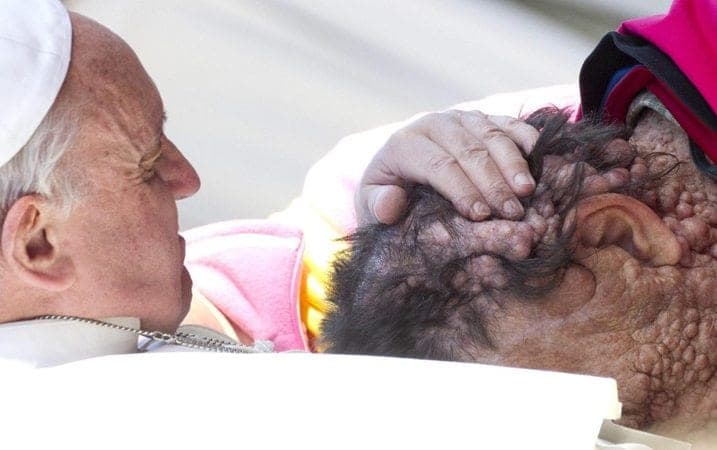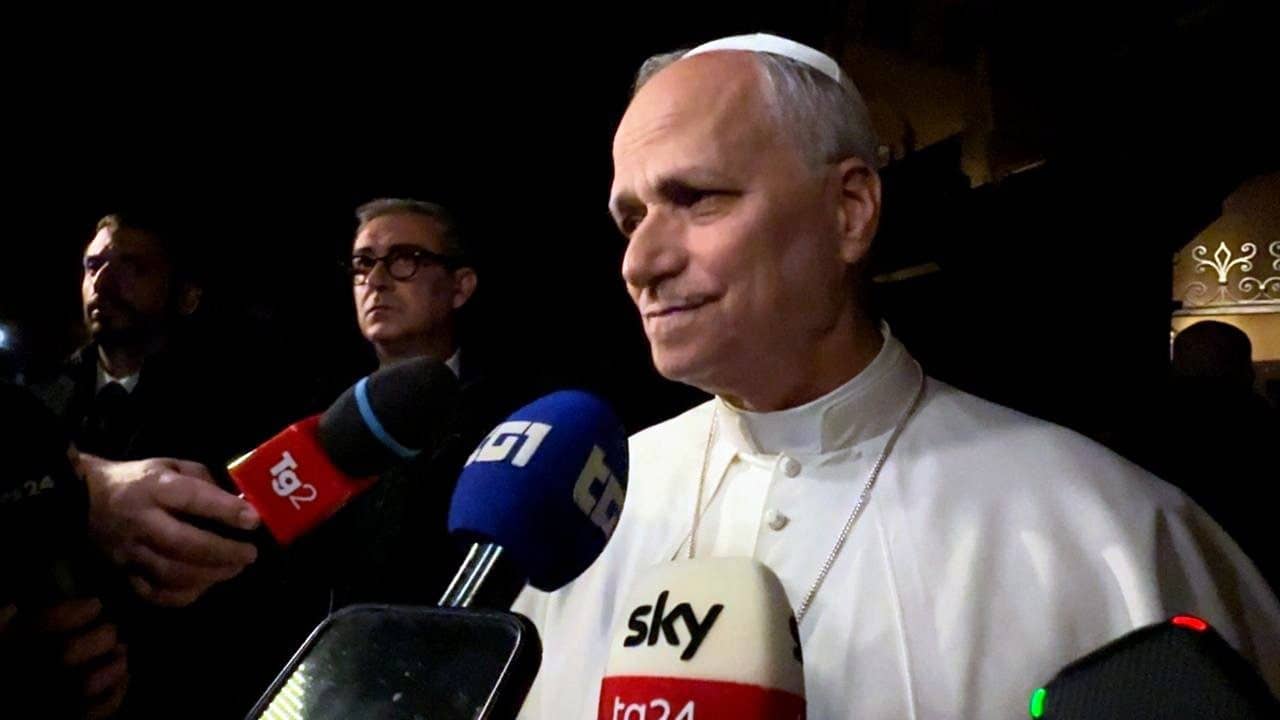“Has there been another world leader who needed so few words to make his point?” asks Yahoo’s Amy Sullivan.
Early on in Francis’ papacy, one of the hot-button debates commentators were keen on was style v. substance. That is, they wanted to know if Francis’ gestures were merely symbolic, or if they in fact signaled a pragmatic shift in Church doctrine and governance.
After several months into the papacy, Michael Sean Winters came to a conclusion: “It is now obvious that the style is the substance,” he said.
In other words, within the context of a religion of sacraments, Francis’ gestures, no matter how subtle, are meant to point to truths and realities beyond themselves.
When he washes the feet of inmates on Holy Thursday, when he kisses the heads of people with disabilities, when he dons a bright red clown nose and giggles with newlyweds — in these fleeting moments, Francis communicates eternal, timeless truths: God serves, God mourns, God laughs.
Given Francis’ ability to infuse even the simplest gesture with a wealth of significance, it’s worth a look at a few of the iconic moments that so far have helped define his papacy. Here are seven of them.
1. Wearing a clown nose
In 2013, Pope Francis donned a red nose to surprise two newlyweds who are volunteers with the Rainbow Association Marco Lagulli Onlus, a charity that offers clown therapy to sick children.
In November 2013, Francis donned a clown nose as he joked around with a newlywed couple. The image quickly spread around the world, and confirmed what we all knew about the pontiff: his is a papacy of joy. Of laughter. Of smiles.
In September, the Pontifical Mission Societies launched its #JokeWithThePope initiative, certainly an appropriate outreach given Francis’ own love of wisecracks. During one extemporaneous speech in Philadelphia, while talking about the difficulties that families face, he said, “Families, we quarrel, and sometimes plates can fly. And children bring headaches. I won’t speak about mother-in-laws.”
Francis has consistently called Catholics to live joyful lives. Indeed, his first encyclical was called “The Joy of the Gospel,” which called for “the Christian faithful to embark upon a new chapter of evangelization marked by … joy.”
With a signature turn of phrase, Francis warned Catholics to be on guard against the “defeatism which turns us into … sourpusses.”
2. On the cover of The Advocate
When Francis made the cover of TIME magazine, no one was really shocked. However, many eyebrows raised when The Advocate, the nation’s leading LGBT publication, made him its Person of the Year in 2013. Although Church teaching on human sexuality remains debatable, reads the story, “none of that should lead us to underestimate any pope’s capacity for persuading hearts and minds in opening to LGBT people, and not only in the US, but globally.”
Indeed. Perhaps the defining line of Francis’ papacy will be “Who am I to judge?” — a rhetorical question he asked during a discussion of a reportedly gay priest. Francis, like his predecessors, affirms male-female marriage, but he has certainly gone out of his way to welcome LGBT into the Church.
3. Stumbling up steps as he boarded a plane
Pope Francis stumbled as he climbed the stairs to his plane at John F. Kennedy International Airport on Sept. 26, 2015 in New York. (John Paraskevas/Newsday via AP)
On Sept. 26, as Francis boarded a plane to carry him from New York to Philadelphia, he had some trouble making it up the steps. As the wind gusted around him, Francis, carrying only his briefcase, fell forward near the top of the stairway, but caught himself.
Francis’ trouble with the stairs also signaled what the 78-year-old has several times reminded his flock: He’s getting old.
On a return flight from Korea in August 2014, Francis said, “I try to think of my sins, my mistakes, so as not to think that I am somebody. Because I know this will last a short time, two or three years, and then to the house of the Father.” For several months, Francis’ doctors have ordered him to eat less pasta and lose some of the weight he packed on since assuming the papal throne.
Also, the pope has lost part of one lung.
Given the enormous pressure placed on popes, Francis is no doubt sincere when he asks the faithful to keep him in their prayers. “Pray for me — don’t forget!” were Francis’ closing words in Philadelphia.
This request has become a familiar Francis refrain, going back to his first public address as pontiff. “Before the bishop blesses the people I ask that you would pray to the Lord to bless me,” he said to those in St. Peter’s Square, “the prayer of the people for their bishop.”
It was also his first tweet:
Dear friends, I thank you from my heart and I ask you to continue to pray for me.
Pope Francis.— Pope Francis (@Pontifex) March 17, 2013
4. Praying at the Wailing Wall
Pope Francis prayed at the Western Wall in Jerusalem May 26, 2014. (Paul Haring/CNS)
The image of Pope Francis reverently leaning his head in prayer against the Western, or Wailing, Wall in 2014 has come to define his first papal trip to the Holy Land. Francis was accompanied to the Wall by Rabbi Abraham Skorka and Muslim leader Omar Abboud. While there, Francis offered a silent prayer and, as is customary, placed a handwritten note between the stones: The note contained the words of the Lord’s Prayer.
Francis’ trip to the Middle East wasn’t universally received. Some took umbrage at his visit to Bethany’s Separation Wall two days earlier. Francis’ visit to the wall dividing Israel and Palestine seemed to suggest that Francis, like his predecessor Benedict, supported a 2012 UN vote to make Palestine a non-member Observer State.
Francis is no stranger to global conflict. Forged in the fires of the Dirty War, the Pope has been an intrepid voice crying out for world peace. In his 2013 Urbi et Orbi message, he preached, “Christ is our peace, and through him we implore peace for all the world.”
Like his saintly namesake, Francis cares deeply about interfaith dialogue. In a meeting with Jewish leaders at the Vatican in June 2013, Francis said, “Because of our common roots, a true Christian can never be anti-Semitic.” The Catholic Church, he said, “firmly condemns hatred, persecution, and all manifestations of anti-Semitism.”
5. Riding around the US in a Fiat
Pope Francis arrived in a Fiat 500L on Capitol Hill in Washington, Thursday, Sept. 24, 2015, for a speech before a joint meeting of Congress. (Steve Helber/AP)
Although many have noted that the affordability of this non-luxury car is in line with Francis’ emphasis on standing in solidarity with the poor, there might be another, theologically-suggestive reason for his stateside car of choice.
The word “fiat” is a Latin word which translates to “let it be done,” which is how Mary responded to the angel who told her she’d give birth to Jesus. “I am the Lord’s servant,” she said. “Let it be done to me according to your word.” The same verb appears in the creation stories in Genesis: “Let there be light!”
Given Francis’ emphasis on being open to God, might his Fiat have been a subtle wink to those paying attention to follow the example of Mary and submit to the will of God?
6. Preaching in the Philippines
People raised statues of Santo Nino, the Holy Child Jesus, as Pope Francis arrived to celebrate Mass in Rizal Park in Manila, Philippines, Jan. 18. (Paul Haring/CNS)
Francis won’t be scared away by a little rain — or even a lot of rain!
In January, the pope kept dry with the help of a bright yellow poncho as he lead a Mass in Tacloban, the capital of Leyte, Philippines. In spite of the fact that his advisers warned him not to hold an outdoor Mass in such stormy conditions, Francis did what he wanted, and said Mass for the 500,000 faithful who turned out to see him.
The image takes on a heightened significance when you realize Francis was there to comfort those who survived the devastating Typoon Haiyan, which killed about 6,300 people. “I don’t know what to say to you,” he said. “But the Lord does know what to say to you. Some of you have lost part of your families. All I can do is keep silence and walk with you all with my silent heart.” Standing with his audience outside in a yellow poncho communicated his solidarity with them.
Francis has often expressed his desire that priests and parishioners get outside of the Church’s walls to help those in need. “Instead of being just a Church that welcomes and receives by keeping the doors open,” he told America, “let us try also to be a Church that finds new roads, that is able to step outside itself and go to those who do not attend Mass, to those who have quit or are indifferent.”
7. Kissing a deformed man
A kiss (usually for babies) is something popes are known for. But Francis’ kisses have earned him extra attention — and particularly, the kiss he gave to Vinicio Riva, an Italian man with neurofibromatosis type 1, a disease that has left him covered with sores all over his body.
Though Vinicio has gotten used to looks of disgust from strangers, as he told CNN, Francis didn’t hesitate to embrace the disfigured man. “He didn’t have any fear of my illness,” said Riva. “He embraced me without speaking … I quivered. I felt a great warmth.”
The moment is a testimony to Francis’ constant preaching to look out for the disenfranchised among us. All life has inestimable value, he said in July 2013, “even the weakest and most vulnerable. The sick, the old, the unborn, and the poor are masterpieces of God’s creation, made in his own image, destined to live forever, and deserving of the utmost reverence and respect.”























